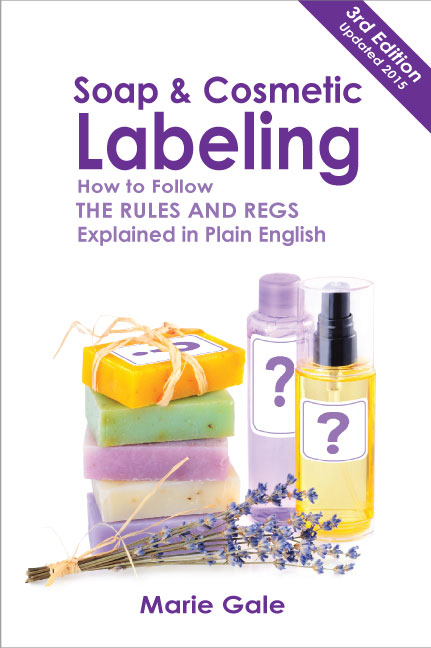While most of my writing has been on the subject of United States regulations, the truth is that nearly all major countries have very comparable laws when it comes to labeling soap and cosmetics. The US is a bit more lenient when it comes to soap, and to registration and pre-approval.
The reason for the similarities in labeling laws is the International Cooperation on Cosmetics Regulation, a group made up of regulatory bodies from the US, Canada, Japan, Brazil, and the European Union, which meets annually. Their purpose is to:
“Maintain and enable the highest level of global consumer protection by working towards and promoting regulatory convergence, while minimizing barriers to international trade.”
In other words, they meet to work out ways that they can make the regulations in each country similar enough so that regulations make sure that consumers are protected (safety) and companies can sell products internationally without having to change labels and formulations from country to country.
They are currently working on issues such as nanotechnology, animal testing, allergens, lead, product preservation, and trace contaminants. Labeling and good manufacturing practices were addressed in 2008 – 2010.
Similarities and Differences
The following information is a general overview and should not be considered a complete list of all applicable laws/regulations in each country.
Almost All Major Countries
Almost all major countries, including those participating in the ICCR, as well as Australia, require the following information on cosmetic products:
- Identity and/or function of the product, AND
- Net weight, AND
- Name and address of responsible party, AND
- Ingredients:
- May be listed
- in descending order of predominance
- all ingredients present at 1% or greater in descending order of predominance, followed by ingredients present at less than 1% listed in any order
- May use a specific term to denote fragrance materials (depends on country)
- May be listed
United States
- Use “fragrance” in ingredient list for all fragrance materials.
- Names used to list botanical ingredients should be the common English name, rather than the Latin name used in the INCI listings.
- Products must not be adulterated or misbranded.
- It is the responsibility of the manufacturer to determine safety (only a few ingredients are specifically prohibited or restricted by regulation or law)
- Only approved color additives may be used in cosmetics.
- Soap is exempt from the definition of a cosmetic under certain circumstances.
- Net contents must also be listed in fluid ounces for liquid products or avoirdupois (by weight) ounces for solid/semi-solid products.
- Registration for cosmetic manufacturers voluntary
Regulatory body: Food and Drug Administration
Primary applicable laws: Food, Drug and Cosmetic Act and the Fair Packaging and Labeling Act.
European Union
- Label requires:
- Date until which the cosmetic product will continue to fulfil its initial function
- Batch number
- “Parfum” or “aroma” to denote fragrance materials.
- Certain substances must be listed in ingredient declaration if present, even if only as constituents of other ingredients (i.e. some essential oil constituents)
- Prior to marketing, a notification must be give to the Commission
- There is a list of prohibited and restricted substances for use in cosmetics (long lists!)
- The is a list of acceptable colorants and preservatives, and only those may be used.
- Animal testing is prohibited
- Nano materials subject to limitations and specific labeling requriements
Regulatory Body: European Commission – Cosmetics
Primary applicable laws: EC No 1223/2009 (as amended)
Member states may have additional laws, regulations and/or requirements.
Canada
- Labeling:
- Information must be shown in both English and French (except for the INCI name)
- Botanical ingredients must be listed with at least the genus and sepcies portions of the INCI name.
- Fragrance may be listed as “parfum”; Flavor may be listed as “aroma.”
- At least 10 days before a cosmetic product is sold, the manufacturer or importer must notify Health Canada. Information required on the form includes name of manufacturer, name, form, and function of cosmetic, list of ingredients with amounts (ranges are acceptable, using a provided chart). Changes must be notified within 10 days.
Regulatory body: Health Canada
Primary applicable laws: Food and Drugs Act and Cosmetic Regulations
Australia
- Labeling is virtually identical to US.
- Soap and cosmetic manufacturers must register with the National Industrial Chemicals Notification and Assessment Scheme (NICNAS) (There is an annual fee.)
Regulatory bodies:
- For business and product “chemcial” registration: NICNAS
- For product safety compliance and enforcement: Product Safety Australia
- Meausurement, net weight (and scales): National Measurement Institute > Pre-Packed Goods
If you have more information about the laws or regulations in Canada, European Union or Australia, from EU member states, or from other countries, please add it to the comments or email me directly so I can include it here.


Leave a Reply